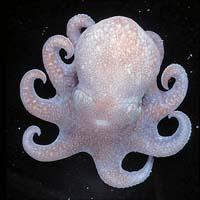The ancestor of many octopus, etc.

It seems that several species of marine octopus separated from a single ancestor about 30 million years ago. Its closest relative, the octopus Megaleledone setebos, is still alive in the Antarctic Ocean and have found some specimens of this species in the census of marine living beings that are being made worldwide (COML).
Scientists participating in the census have tried to explain how the ancestor of today's octopus spread to the oceans around the world. It seems that 30 million years ago Antarctica cooled and increased the ice layer. When something like this occurs, fresh water forms an ice layer and leaves under water with high concentrations of salt and oxygen. Having more salt, this water sinks because it is denser.
Logically, along with the water, the octopus that lived there sank, and the currents of the seabed caused them to expand to the waters of the seabed around the world. When isolated in the new settlements, they evolved to create the current species.
For this reason, numerous findings have been made in the aforementioned Padrón. In 2000, 2,000 scientists from 82 countries began to investigate the seas around the world. The census is scheduled to end in 2010, but the work done to date has been released at the World Conference on Marine Biodiversity held in Valencia in November.
Buletina
Bidali zure helbide elektronikoa eta jaso asteroko buletina zure sarrera-ontzian











